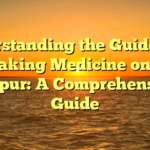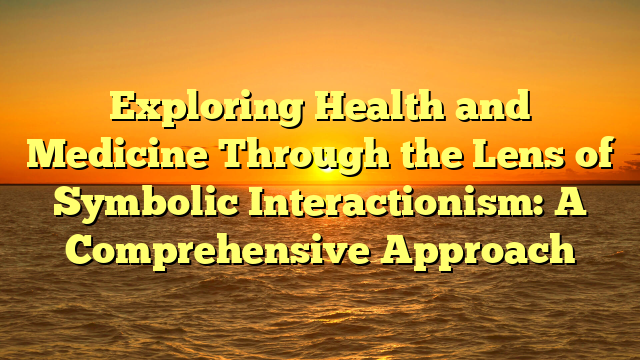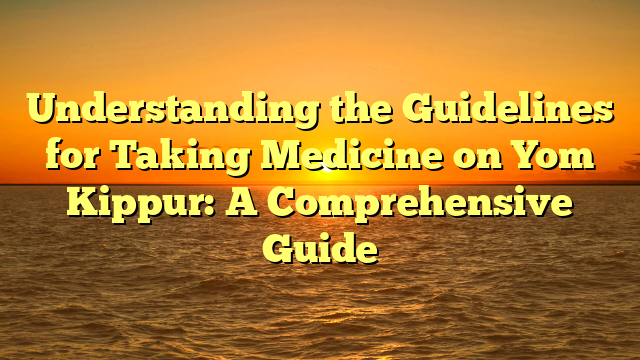Exploring Health and Medicine Through the Lens of Symbolic Interactionism: A Comprehensive Approach
Introduction
Symbolic interactionism is a sociological perspective that focuses on the ways in which individuals create and interpret symbols to give meaning to their social interactions. This approach can be applied to various fields, including health and medicine. By examining the role of symbols and interactions in the context of health and medicine, we can gain a deeper understanding of how individuals perceive and experience these aspects of their lives.
Theoretical Framework: Symbolic Interactionism
Symbolic interactionism, developed by sociologist George Herbert Mead, emphasizes the importance of symbols and interactions in shaping human behavior and social reality. According to this perspective, individuals interpret symbols based on their own meanings and use these interpretations to guide their actions. In the context of health and medicine, symbolic interactionism allows us to explore how individuals construct and negotiate meanings related to their health, illness, and medical encounters.
Key Concepts of Symbolic Interactionism
There are several key concepts within symbolic interactionism that are relevant to understanding health and medicine:
- Symbols: Symbols are objects, gestures, words, or behaviors that carry shared meanings. In the context of health and medicine, symbols can include medical equipment, doctor-patient interactions, and even the presence of a hospital.
- Meaning: Meaning refers to the interpretations individuals give to symbols. For example, a stethoscope may hold different meanings for a doctor and a patient.
- Interactions: Interactions involve the exchange of symbols between individuals. In the context of health and medicine, interactions can occur between healthcare providers and patients, as well as among patients themselves.
- Self: The self is the individual’s sense of identity and is shaped through interactions with others. In the context of health and medicine, individuals may develop a “sick role” identity when they are experiencing illness.
Applying Symbolic Interactionism to Health and Medicine
Symbolic interactionism offers a comprehensive approach to understanding health and medicine by examining the ways in which individuals create and interpret symbols in these contexts. By exploring the meanings individuals attach to symbols related to health and medicine, we can gain insights into their experiences and behaviors.
Symbolic Meanings of Health and Illness
Health and illness are not simply objective states but are also socially constructed concepts. Symbolic interactionism allows us to explore the meanings individuals attach to these concepts and how these meanings influence their behaviors and interactions.
For example, the symbol of a hospital may hold different meanings for different individuals. For some, it may represent a place of healing and hope, while for others, it may evoke feelings of fear and anxiety. These symbolic meanings can shape individuals’ experiences and interactions within healthcare settings.
Doctor-Patient Interactions
Symbolic interactionism also provides insights into doctor-patient interactions. These interactions involve the exchange of symbols, such as verbal and nonverbal communication, medical diagnoses, and treatment plans.
Through the lens of symbolic interactionism, we can examine how these symbols are interpreted and negotiated by both doctors and patients. For example, a doctor’s white coat may symbolize authority and expertise, while a patient’s symptoms may be interpreted as symbols of illness. Understanding these symbolic meanings can help improve communication and enhance the doctor-patient relationship.
Research Methods
Symbolic interactionism can be applied to health and medicine through various research methods. These methods allow researchers to explore the meanings individuals attach to symbols and interactions in these contexts.
Qualitative Interviews
Qualitative interviews provide an in-depth understanding of individuals’ experiences and perspectives. Researchers can use this method to explore the symbolic meanings individuals attach to health, illness, and medical encounters. By analyzing the narratives and interpretations provided by participants, researchers can gain insights into the ways in which individuals construct and negotiate meanings related to health and medicine.
Observation
Observation allows researchers to directly observe and document interactions in healthcare settings. By observing doctor-patient interactions, for example, researchers can identify the symbols and gestures used by both parties and analyze how these symbols are interpreted and responded to. This method provides valuable insights into the dynamics of healthcare interactions and the symbolic meanings attached to them.
Conclusion
Symbolic interactionism offers a comprehensive approach to exploring health and medicine. By examining the role of symbols and interactions in shaping individuals’ experiences and meanings related to health and medicine, we can gain a deeper understanding of these aspects of human life. Applying symbolic interactionism to research in health and medicine can help improve communication, enhance patient experiences, and inform healthcare practices.
References
Insert your references here.











